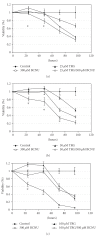Troglitazone reduces glyoxalase I protein expression in glioma and potentiates the effects of chemotherapeutic agents
- PMID: 20454582
- PMCID: PMC2864507
- DOI: 10.1155/2010/373491
Troglitazone reduces glyoxalase I protein expression in glioma and potentiates the effects of chemotherapeutic agents
Abstract
Despite resistance of most gliomas to chemotherapy, approximately 2/3 of oligodendrogliomas show sensitivity to such agents. This sensitivity has been associated with deletions on chromosome 1p alone or in combination with 19q. Higher expression of the enzyme glyoxalase I has been found in oligodendrogliomas with chromosome 1p intact compared to those with a deletion. Higher expression of this enzyme is also associated with tumor chemoresistance in other cancers. The present study tested whether the drug troglitazone would make a glioma cell line more sensitive to chemotherapeutic agents. This drug was chosen because it has been shown to decrease glyoxalase I enzyme activity in cells. Treatment with troglitazone decreased expression of glyoxalase I, and potentiated cell death when used in combination with chemotherapeutic agents. This decrease in glyoxalase I protein may be one mechanism by which this potentiation occurs, and troglitazone may be a candidate for use in glioma therapy.
Figures




Similar articles
-
Allelic losses at 1p36 and 19q13 in gliomas: correlation with histologic classification, definition of a 150-kb minimal deleted region on 1p36, and evaluation of CAMTA1 as a candidate tumor suppressor gene.Clin Cancer Res. 2005 Feb 1;11(3):1119-28. Clin Cancer Res. 2005. PMID: 15709179
-
Evaluation of chromosome 1p/19q deletion by Fluorescence in Situ Hybridization (FISH) as prognostic factors in malignant glioma patients on treatment with alkylating chemotherapy.Cancer Genet. 2023 Nov;278-279:55-61. doi: 10.1016/j.cancergen.2023.08.005. Epub 2023 Aug 10. Cancer Genet. 2023. PMID: 37625215
-
Molecular cytogenetic analysis of chromosomes 1 and 19 in glioma cell lines.Cancer Genet Cytogenet. 2005 Jul 1;160(1):1-14. doi: 10.1016/j.cancergencyto.2004.11.012. Cancer Genet Cytogenet. 2005. PMID: 15949564
-
[Diagnostic and prognostic values of 1p and 19q deletions in adult gliomas: critical review of the literature and implications in daily clinical practice].Rev Neurol (Paris). 2008 Jun-Jul;164(6-7):595-604. doi: 10.1016/j.neurol.2008.04.002. Epub 2008 May 21. Rev Neurol (Paris). 2008. PMID: 18565359 Review. French.
-
[Histological and molecular classification of gliomas].Rev Neurol (Paris). 2008 Jun-Jul;164(6-7):505-15. doi: 10.1016/j.neurol.2008.03.011. Epub 2008 Jun 10. Rev Neurol (Paris). 2008. PMID: 18565348 Review. French.
Cited by
-
The Dual-Role of Methylglyoxal in Tumor Progression - Novel Therapeutic Approaches.Front Oncol. 2021 Mar 22;11:645686. doi: 10.3389/fonc.2021.645686. eCollection 2021. Front Oncol. 2021. PMID: 33869040 Free PMC article. Review.
-
Inhibition of GLO1 in Glioblastoma Multiforme Increases DNA-AGEs, Stimulates RAGE Expression, and Inhibits Brain Tumor Growth in Orthotopic Mouse Models.Int J Mol Sci. 2018 Jan 30;19(2):406. doi: 10.3390/ijms19020406. Int J Mol Sci. 2018. PMID: 29385725 Free PMC article.
References
-
- Norden AD, Wen PY. Glioma therapy in adults. Neurologist. 2006;12(6):279–292. - PubMed
-
- Cairncross JG, Ueki K, Zlatescu MC, et al. Specific genetic predictors of chemotherapeutic response and survival in patients with anaplastic oligodendrogliomas. Journal of the National Cancer Institute. 1998;90(19):1473–1479. - PubMed
-
- Okamoto H, Li J, Gläsker S, et al. Proteomic comparison of oligodendrogliomas with and without 1pLOH. Cancer Biology and Therapy. 2007;6(3):391–396. - PubMed
-
- Thornalley PJ. Protecting the genome: defence against nucleotide glycation and emerging role of glyoxalase I overexpression in multidrug resistance in cancer chemotherapy. Biochemical Society Transactions. 2003;31, part 6:1372–1377. - PubMed
-
- Thornalley PJ. Pharmacology of methylglyoxal: formation, modification of proteins and nucleic acids, and enzymatic detoxification—a role in pathogenesis and antiproliferative chemotherapy. General Pharmacology. 1996;27(4):565–573. - PubMed
Grants and funding
LinkOut - more resources
Full Text Sources

